August 2006 archives
you are here [x]: Scarlet Star Studios > the Scarlet Letters > August 2006
<< before
July 2006
after >>
September 2006
August 28, 2006
steel armature progress
by sven at 9:49 pm
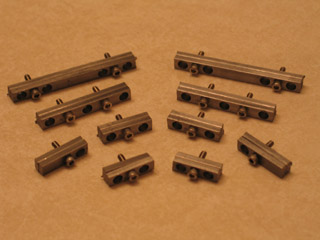
I'm about halfway through making my first all-steel armature. The design is nearly identical to the one I used for my last brass armature. The exceptions:
- sandwich plates are 1/8" thick
- holes for the balls are 3/16" wide
- I'm using solid 5/16" type 302 stainless steel balls instead of 8mm beads
- the legs are slightly shorter, as is the neck
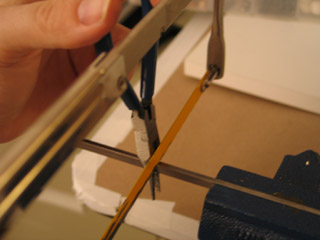
I've come up with a handy trick for getting the hacksaw started. I use a pair of pliers as a straight edge. Before I tried this, I was having trouble with the saw skipping.
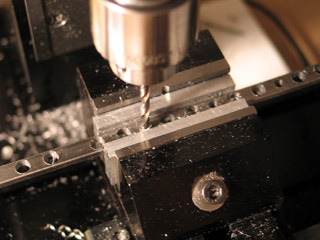
I'm using my "sushi roll" method again: drilling all the holes in two long strips, then chopping the strips into individual joints. Now that I'm working with a mill, I very much like the precision of using its XY table.
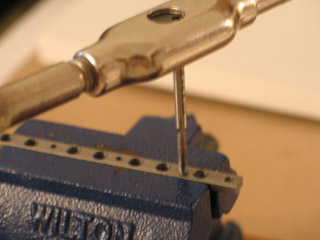
Steel is more difficult to tap than brass. I broke two taps while threading holes... It's just the price of learning. I think I've got the hang of it now. Use lots of lubricant, only turn a little ways, then turn the tap back far enough so that you're definitely breaking off the metal chips. Squeaking is a bad sign.
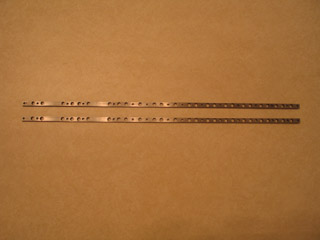
Here are the two strips before they get chopped up. In theory, what you're looking at is all of the sandwich plates, laid out in two straight lines...
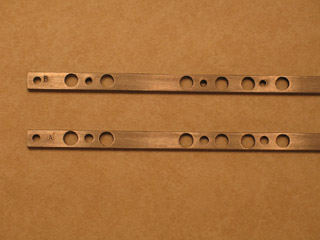
Unfortunately, I discovered too late that my milling vise got out of alignment while I was working. You can see that some of the holes aren't perfectly centered. I had to go back and re-make the effected joints.
Incidentally, the cutting speeds I listed in my last steel armature update were incorrect. Since then, I've figured out how to do the calculations that determine RPM for a specific diameter (and shape) of cutter based on the properties of whatever metal you're choosing to work with. There isn't just one RPM for each kind of metal; it depends upon a number of factors.
posted by sven | permalink | categories: stopmo
August 27, 2006
poem: on being a lonely planet
by gl. at 6:16 pm
i've been meaning to write a poem about pluto being reclassified as a "dwarf planet," leaving us with eight "classical" planets. i'm such a science geek. :) of course, it's hardly ever just about the science....
On being a lonely planet
Nobody wants to dance with
a planet with an eccentric orbit
and its lopsided satellite
nobody wants a long-distance relationship with
a rejected planet in the coldest, darkest sky.
You scramble to keep up with the warmer lives
of the elite inner planets from afar
watching their round orbits and their shining faces
but they don't want you asking too many questions
and your quiet deviance is mistaken as dimness.
Neptune's as close as he ever was
but he seems more distant, somehow
your paths still cross
but your conversations are stiff and remote.You never needed to be the center of the universe
you're not afraid to be alone
but loneliness creeps in, anyway.
Once discovered, you thought you'd always
be included, but now neglected
your only friends are other outcast asteroids.
You're a planet with a good heart, and
your years are long ones,
alternating between sunlight and night.
But don't get your hopes up:
I've seen this happen before
and no amount of pennies or pomegranate seeds
will bring you back into the fold....august 27, 2006...
dedicated to the planet formerly known as pluto
posted by gl. | permalink | categories: writing
August 26, 2006
hamilton mattress
by sven at 10:03 pm
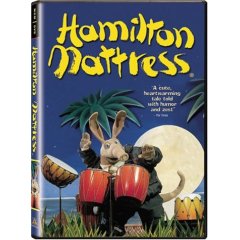
We just watched "Hamilton Mattress," a half-hour stopmo film about an aardvark who wants to be beautiful. FANTASTIC!! Better than the first Wallace & Gromit shorts, in my opinion. I was charmed, delighted, enthralled.
Great characters. Lively, fun acting. Tight, elegant, lovely story. Excellent use of color. Beautifully crafted sets. Not high art, but an appealing-to-all-ages fable. A paragon of what stopmo can be.
The "making of" featurette has some interview material with Barry Purves, who's mentioned in a number of stopmo books as a great in the medium. Puppets by MacKinnon & Saunders (foam latex, I'm pretty sure) -- whom you know as the fabricators for Corpse Bride.
The copy I have was gifted to me by our friends Kristen and Todd. I see that it can be had via Amazon.com. It's probably available via NetFlix, too.
Add it to your "must see" list.
posted by sven | permalink | categories: stopmo
August 25, 2006
wishes & fishes
by gl. at 10:35 pm
on wednesday we hosted the Fabulous End-of-Summer August Art Swap! i wanted people to give & get "new" art supplies for free. i figured people would be able to find good homes for the things that no longer inspire them and discover new treasures at the same time. i had it brewing in the back of my head for a while, but finally decided that if i waited until i figured out all the details, it would never happen, so i took the opportunity of our early august canadian trip and the upcoming artist's way creative clusters to create a new, fun, unusual event for us.
anyway, it was great! the studio swelled with art supplies and generous hearts. we got some new attendees out to the studio for this event, too! there were some amazing finds representing a wide range of arts, and i tucked homegrown tomatoes from the studio garden fairies into leftover gift bags i had been hoarding for years. i also managed to pass out flyers for the artist's way creative clusters and the general events flyer. we even had pizza!
since this was the first art swap i've ever held, the timing was a little off and i could have used even more space for people to swarm the goods when the time came. but i got a couple of details really right:
i created little tags for people to fill out for the items that had stories attached to them or that had non-obvious functions. this gave people something to do when coming in and really made the items more personable during the swap. "what is it? why is it here?"
but the biggest success was born from my main concern for this event, which was "how am i going to keep people in the studio for longer than 30 minutes?" i mean, how long does it take to drop stuff off and sort through a table of odds & ends?
i've been watching the TEDtalks and am inspired by the presenters who have been granted a TEDprize. more specifically, i'm fascinated by the concept of granting someone a "wish" which everyone listening promises to help make come true by donating time, resources, money, expertise, or connections to make it possible. later i realized i've probably also been influenced by wishcraft & dayna's description of wishweavers.
but the TED concept is what prompted the major activity of the evening, which is choosing a wish to share with others. as artists, these are the kinds of conversations we should be having! we don't know who among us will be able to help, but someone will if we wish loudly enough & often enough. but first you have to wish so people can hear it. :) so while waiting for everyone to arrive, i asked people to create nametages that also included an "implausible wish or desire" --- and then talk with each other about them, each person having a chance to wish and listen. this turned out even better than i hoped because it gave us a reason to talk about what we want rather than the typical small talk about what we do. at 8 p.m. we paused before the swap to introduce ourselves and our wishes so that everyone would have a chance to hear them. there was so much good feedback we went longer than i expected, but it was an amazing bonding experience.
so these are some of the wishes people had. can you help make any of one of them come true?
grand & ephemeral
L surprised herself by wanting to be a philanthropist: she wants to inspire & support artists. does anyone know of a grant that needs managing, or a way to break into fundraising or art support funds?
A wants to ride the Orient Express! does anyone know of a way to make that happen? is there a job she could do or a contest she could win or become the guest of someone planning on taking a trip? is there an art magazine that would pay her to write an article or publish an art journal based on the trip?
J wants to travel around in an Airstream RV. does anyone know where she could pick up one of these for $4000 or less?
T wants abundant energy to drive her music, lit & photography passions. does anyone know of massage therapists or alternative healers that could help with this sort of thing?
places & spaces
CH is looking for an affordable ranch house in inner SE by October. she currently lives in NE, but her husband is disabled and her daughter is in a SE language school. is anyone selling something like this, or knows of a good real estate agent who would work with them?
i'm looking for a piece of green/wilderness property i could access to create an Andy Goldsworthy-like workshop (or a place to set up our labyrinth!). i'd consider a retreat space, but i'm wondering if anyone has a good chunk of backyard or property somewhere they'd be willing to let me borrow ocassionally.
B is looking for a commercial/residential mixed space in SE for about $400,000. does anyone know of a space like this or a real-estate agent she could work with?
jobs & such
Linda Womack wants to make all of her income from art (encaustics & teaching). i invited her to teach a workshop at the studio, but you can help make her wish come true by buying her art, visiting her during the Open Studios tour, or taking one of her classes at collage.
M wants to start a center for healing & art therapy (and publish a book). she's looking for a group of dedicated people to create a board with a potential committment of 2 years. (i volunteered for this.)
C wants to illustrate & publish a children's book. does anyone know publishers in this market, or has anyone published a children's book that could act as a mentor?
JB is an art therapist looking for private clients. i invited her to teach a workshop at the studio, but does anyone want to try art therapy, or need a coach on the road to certification?
B wants to quit her job at the flower shop in Salem and design webpages instead. does anyone have small, simple sites she can set up for creative people?
and sven wants to work on Coraline at Laika. :) grace & leopoldo have done wonders so far, but is there anyone with a direct line to the armature head who can be sven's advocate?
this was a wonderful way to wrap up summer and look forward to fall. the studio can't absorb the remainders from another art swap for at least a year (though collage fairies shouldn't be shy about intermittent donations!), but i'm going to check in w/ wednesday's dreamers in three months and see what we've done to make each other's dreams come true.
while not everything was totally perfect, i really thought it went pretty well. though there are always improvments & tweaks to be made for next time, my only regret is that i didn't get that many pictures, and the ones I did get were thanks to sven (thanks, sven!). so if you want to see a few pictures, they're at the meetup site.
now to begin promotion for the artist's way creative clusters that begin sept12! (and if i had a second wish, it would be that both the tuesday night & wednesday morning clusters would have enough participants to run this term! so pass along that link to anyone you think would benefit from a dedicated creative group like this. :)
posted by gl. | permalink | categories: artist's way
August 20, 2006
a new jig for radiusing
by sven at 8:36 pm
Before our vacation to Canada, I had started working out how to make my first steel armature. During the past few days I've made some new progress.
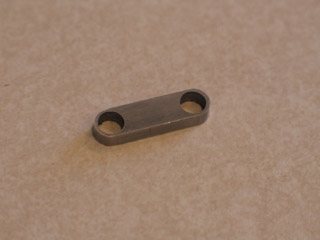
Above you see a "sandwich plate." A pair of these would sandwich two steel balls, making an "open hole double ball" joint. Rounding off the ends of the plate is called "radiusing." Figuring out how to do that rounding took a lot of effort. It's my big success for the day.
[The simple solution would be to hand-file the curve. However, I'm making this armature for show, and want it to look fancy. Figuring out how to do radiusing is also a good learning project, to help me get used to my new milling machine.]
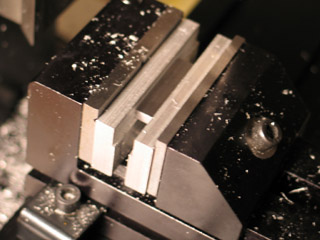
If you're going to drill holes through plates, then you need to put spacers underneath, so the drill bit doesn't cut into your milling vise. What I've done is cut a little .03" shelf into two pieces of aluminum. This is just enough room for supporting the 1/4" wide bar, while letting the 3/32" dia. drill bit pass through unhindered.
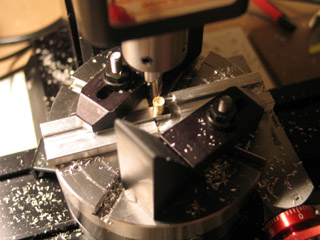
To hold the sandwich plate in place for radiusing, I needed a jig. My first attempt was successful -- but it was miserable trying to get the rotary table centered under the spindle, squaring the jig to the milling table, and clamping the jig down with step block hold-downs... Too fiddly, and the jig was liable to come loose whenever I unclamped a sandwich plate in order to put another in.
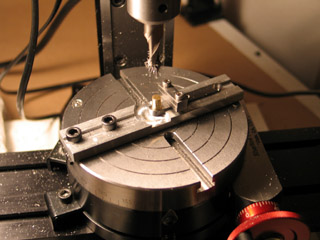
I modified the jig design, drilling holes in one side so I could use socket cap screws and T-nuts to clamp the jig directly to the rotary table. I also added two 4-40 screws on top of the jig, so a little bar could be screwed down to hold the sandwich plate in place. These changes made clamping much easier and more reliable...
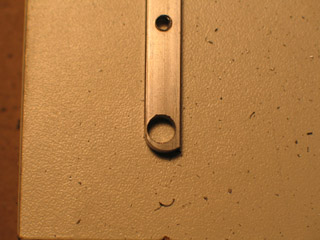
...However, I didn't have the holes in the jig perfectly centered. Consequently, the jig was imperceptably angled on the rotary table. Turning the table amplified a small error; so rather than rounding off the plate's end, I got a wonky arc.
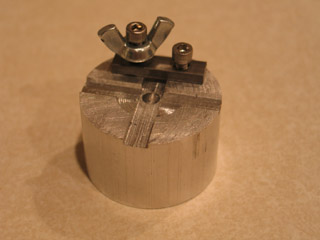
Friday night I finally had my "ah-ha!" moment. Most of the misery here has to do with getting the jig perfectly centered... Well, a lathe chuck is designed to get things perfectly centered -- and the rotary table came with an adaptor so you can attach a lathe chuck. A round jig should do the trick!
Saturday I went out to Metal Supermarkets and picked up a 1" length of 1.5" dia. aluminum rod. A little more than six hours later, I finished making the jig you see above.
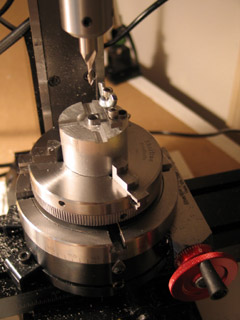
A couple of things I've learned in the course of this project...
RPM for milling aluminum: usually 2500. RPM for milling 1018 steel with a 1/8" end mill: 1000. RPM for milling 1018 steel with a 1/4" end mill: 500.
Everyone says to take shallow cuts -- and they're right. When roughing out the radius, .03" cuts are appropriate. For the final passes, .0010" and .0005" passes are appropriate. Try to take too deep a cut and the jig might buck, the cutter could get stuck, and the accuracy will be bad. In fact, it's best to do your first passes with the cutter not even touching the work, just to make sure that you're not going to suddenly dig into an unexpectedly thick surface.
Working with backlash... If you're moving the XY table to the right and then reverse directions, there's a moment when you're turning the handwheel but the table isn't moving -- because the leadscrew has some play and hasn't grabbed hold yet. This is called "backlash."
Your measurements are only good when you're moving the table in one direction -- if you back up, backlash will introduce uncertainty. So, if you overshoot your mark, you have to back up past the backlash, and then go forward again.
I've got a digital read out (DRO) which can be set to accommodate for backlash -- but I've seen at least one online warning that adding and subtracting backlash to your measurements is an inaccurate method.
My current method for locating the spindle in relationship to something in the vise: I put a piece of 1/8" rod into the drill chuck and move it forward until I hit the edge of the vise... When I hit the edge of the vise, I zero-out the DRO. I back the spindle up a good ways and then, going forward, use the DRO to help me move the spindle to where I need it.
Oh! And I used a fly cutter for the first time. That's a rotating blade that can "quickly" flatten out wide surfaces (up to 2" wide).
I think -- knock on wood -- that I'm just about ready now to start working on the armature proper.
posted by sven | permalink | categories: stopmo
August 16, 2006
30fps - flicker textures
by sven at 9:39 pm
Here's the follow up to 30fps: basic principles. This one runs 2 min 17 sec.
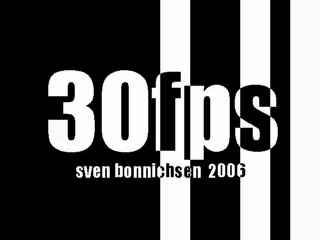
The final "symphony" reminds me a bit of those old electronic "Simon Says" games from the 80s... Or of video game music. Still, it was interesting to identify some more "flicker textures" through playing around: syncopation and strobing.
Music was useful for emphasizing changes -- but it also distracts attention from the flicker more than I'd like.
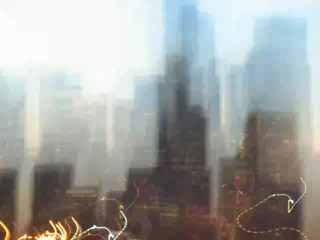
After putting together the basic "symphony," I tried a bunch of different variations. This one uses photos rather than flat colors. It's only 57 sec -- but all that quick flipping between images makes for a very large file size, even when compressed with Sorenson3.
An observation. The eye can read a high-contrast image (like a number) with only one frame. A photo is more difficult to interpret, and seems to require two or more frames for readability.
I could see doing a third "30fps" piece: one that explores using motion clips, rather than just stills... However, it's more likely that I'll just end the series here, and move on to other things now.
posted by sven | permalink | categories: movies
August 13, 2006
30fps - basic principles
by sven at 7:46 am
We're only just back from Canada... And immediately I get one of my signature bouts of inspired insomnia.
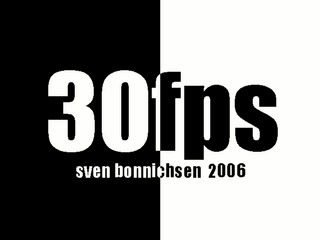
Last night I started typing out a list titled "exploring the formal qualities of stopmo animation." Why? Form precedes content, I think I've decided. I'm just not gushing forth ideas for stories that I want to tell -- but if I spend a while dissecting the empty cinematic container that's meant to transmit stories, I suspect some part of me will start stepping forward to fill the void.
After I went to bed, one of the items on my list developed itself into a full-fledged short film concept -- so I was compelled to get up and execute the idea. Click on the image above to see the film; it runs 1 min 16 sec.
For your additional amusement, here's the passage I wrote that inspired the film:
5. As animation is actually a series of still images displayed rapidly, one might have more than one series of images interspersed with each other, perhaps at varying rates. At a one-to-one ratio, the two story streams would appear superimposed. At a ten-to-one ratio, the minor story stream would become subliminal. There could be not just two, but three or four or more story streams being interspersed at the frame-level of time, each at varying rates. The rate at which a story thread is visible could be constant, or it could change during the course of a film -- e.g. increasing in frequency until it’s visible at a conscious level -- and then receding back to a subliminal rate.
5A. Do the interspersing of frames using nothing but still frames of color. (This isn’t stopmo proper, and there are no evolving story threads -- but it would be a much simplified version of the basic idea, useful for testing how it works in practice.) Each of these colors might be paired with a musical tone, which would both help alert the viewer to new themes, and create an organic soundtrack. ...Backtracking, this raises the question of how a soundtrack would be handled if one were working with actual story threads.
5B. The principle of intermixing different story threads at the single-frame level could be explored even more simply using black and white screens. At its most basic, there are four concepts to demonstrate: unbroken, superimposed, subliminal, and transition. Have the name for each concept in white letters at the top of a black screen, and in black letters at the bottom of a white screen. After demonstrating the four basic concepts, one could move on to demonstrate ratios, e.g. 1:14, 2:13, 3:12, 4:11, 5:10, 6:9, 7:8. (Working in 15fps would probably be most practical.) Having the words for the black screen and the white screen spaced so that they wouldn’t overlap would make it easier to see the principles; for the ratios, it might be more interesting to have the black and white text fall on the same spot on the screen. For sound, perhaps just white screens would have sound (a simple sawtooth tone?) -- black would have silence. If there were a title at the beginning and credits at the end, perhaps it would be appropriate to the medium that they each only be one frame long; using a QuickTime viewer, they would stay visible until the film was set into motion. It might also be appropriate to have the title cards written on gray screens. Possible titles: ratios, intercut, 15fps, stacking frames, impersistent vision... This experiment would do a very good job of laying the groundwork for the color, multi-thread experiment. The title card might also be an explanation, rather than a title -- the title and credit could come at the end. Looking at this project from a practical point of view, it could probably be assembled in AfterEffects by dropping single-frame compositions into a master composition (nesting them), and then using the keyframe assistant command to sequence them.
(Oh so witty... Now may I please go to sleep, please?)